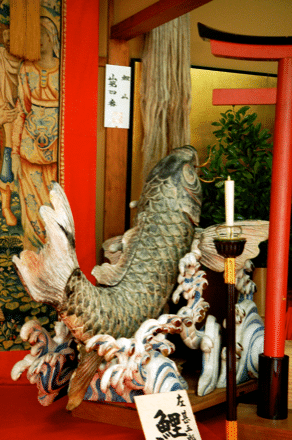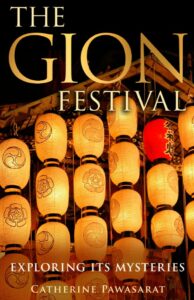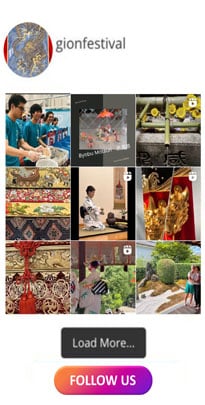The Gion Matsuri abounds with diverse mystical tales and historical legends. One, the koi dragon legend, describes how a humble carp or koi became a powerful dragon.
Part ecology, part life metaphor, part esoteric spiritual teaching, this story has captured a special pride of place in Asian culture. It’s also the main theme of the Koi Yama float, in the Gion Festival’s Ato Matsuri.

Koi image courtesy Koi Story.

Not easy to ascend! Hukou Waterfall on the Yellow River. Image by Leruswing, CC BY-SA 3.0, via Wikimedia Commons.
How the Koi Became a Dragon
The ancient koi dragon folk tale recounts how a humble carp lived in the sea, and aspired to know a different life, a vaster world, and more diverse experiences. The koi met many different creatures, who each helped the carp along its quest. Even animals and demons who tried to eat or hinder it actually helped the koi develop skills, confidence, and resolve.
Historically, every year carp have swum up rivers to spawn, and our legend takes place in China’s Yellow River. As it’s one of the largest rivers on earth and the second longest river in China, swimming up it must be a truly herculean task for koi.
Many thousands of carp attempt the journey, but they must prevail over and through countless cascades and rapids. This requires abundant strength, talent, courage, and perseverance. Naturally, fewer and fewer koi make it further and further upriver.
According to our legend, far upriver there was a very high, extremely steep waterfall called “Dragon Gate.” Its waters thundered with torrential force from a fissure between two lofty mountain peaks.
The numerous carp that had made it upstream gathered at the pool below the waterfall. Only three resolved to ascend the waterfall to the top.
Their efforts spanned years as they tried and failed and tried again, overcoming many formidable obstacles. Finally, only one yellow carp could ascend the falls and then leap over its top.
When this carp finally succeeded, the mythical Jade Emperor rewarded its heroic efforts by transforming it into a dragon with golden scales. Thunder boomed, lightning flashed in the sky, rain fell, and the golden dragon flew off into the sky.
The Gion Matsuri’s Dragon Koi at Koi Yama
Referring to this well-loved legend, the Gion Festival’s Koi Yama float features a koi as its sacred sculpture.
The carved wooden carp is depicted swimming up carved wooden waves combined with spun hemp, representing a waterfall. The koi is positioned just before a Shintō torii gate, representing the Dragon Gate. And The Koi Yama community has adopted the proverb “Climb the Dragon Gate.”
Dragons have a deep, ancient connection with the Gion Matsuri and Kyoto. Besides bringing life-giving rain, dragons can help avert disasters related to too much or too little. Read more about why dragons are so important in the Gion Matsuri in my blog here.
And what does the carp to dragon tale mean for the Gion Matsuri, its communities, and festival-goers? Is this about our lives in this world, or about something more mystical? Let’s take a closer look.

Koi Yama‘s carp leaps through the Dragon Gate during the Ato Matsuri procession.

Golden dragon metalwork, tassel holder, Hōka Boko.

Golden Dragon design on vintage textile, Yamabushi Yama.

Golden dragon metalwork, Niwatori Boko.
A Carp to Dragon Tale of Worldly Success

Statue of carp becoming a dragon, Da Nang, Vietnam. Image courtesy MyGuideVietnam.com.

“Koinobori” streamers flying on Boy’s Day in Japan. Image via Wikipedia commons.
Some humans have also struggled to make a challenging annual ascension. Throughout history hopeful students from around China took the notoriously difficult civil service exams, offered once a year.
Many of these young men (women were ineligible then) had to take the exam several times, year after year, in order to pass, if they passed at all. Like the carp swimming upstream, passing the exams took strength of character, talent, courage, and perseverance.
Why would they try so hard? For many people throughout Chinese history, becoming a government official was the best way to ensure security, increased influence, and prestige, not only for oneself, but for one’s entire family.
Passing the exams came to be known as “climbing the Dragon Gate,” particularly for someone from a remote region, or from a family with less economic means. The dragon’s golden color came to represent wealth, and the accompanying rainfall meant abundant crops, a symbol of bounty for the family.
The transformation of something common and small to something powerful and grand makes the dragon koi legend a popular one. As a result, the carp is also a much-loved symbol for Asian people, particularly boys. Traditionally on Boys’ Day in Japan, parents fly carp-shaped streamers (koinobori or “ascending carp”) in front of their homes.
But is this story really just about security, wealth, and power?
The Koi Dragon Transformation as Spiritual Realization
Japan and Kyoto are both famous for their Buddhist traditions. Nichiren, the Japanese monk who inspired Nichiren Buddhism, used the Dragon Gate legend to describe the pursuit of enlightenment.
But there’s a prominent school of Taoism named “Dragon Gate Taoism,” which combines Buddhism and Confucianism with Taoism. The Gion Matsuri combines these three, too, along with Japanese Shintōism. Could there be a connection?
The Taoist path is fundamentally about living in harmony with the universe. When we are able to do this, Taoists believe, humans are no longer confined to everyday reality as we normally know it.
Right: Carp Leaping The Dragon Gate, by Kumashiro Yuhi, Nagasaki Museum of History and Culture.

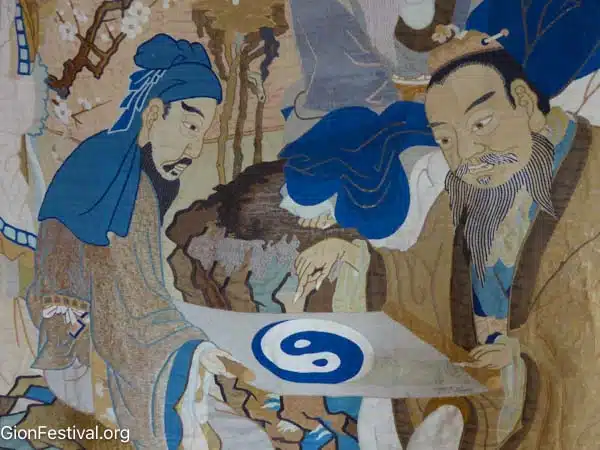
Two Taoist sages contemplate the Yin Yang symbol in this vintage textile that adorned Hoshō Yama for centuries.
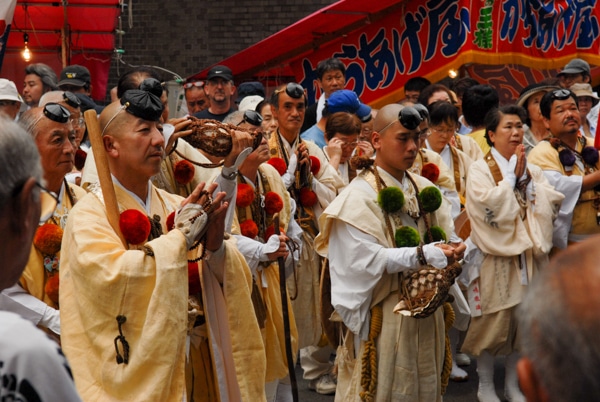
Yamabushi, Shugendō practitioners at the Gion Matsuri. Read more about them in my blog here.
Taoism in the Gion Matsuri and Kyoto
Vintage textiles at several Gion Matsuri floats depict scenes from mystical legends of Taoist Immortals. These indicate that at times Taoism captured the interest of the Kyoto kimono merchants who commissioned Gion Matsuri float adornments.
Kyoto was famously established according to geomancy or feng shui, a Taoist art. Yasaka Jinja, the Gion Matsuri’s patron shrine (older than Kyoto itself), also incorporated elements of Taoism in its design and practices.
And Taoism—Onmyōdo in Japanese—flourished in Kyoto in the Heian Period (794-1185). Amidst this scene lived and trained En no Gyōja, who inspired Shugendō, a syncretic path combining aspects of Taoism, Shintō and Buddhism. He also inspired the Gion Festival’s En no Gyōja Yama, and Yamabushi Yama.
In ways like these, the Gion Matsuri and Kyoto City itself can offer us insights into the history of their different philosophical, cultural, and spiritual influences. After all, Kyoto was one of the ends of the Silk Road.
The question is, what is your Dragon Gate?
Keen to Learn More?
Enjoy the free resources on this site as my gift to you. And know that my book, The Gion Festival: Exploring Its Mysteries, is even better. It’s full of myths, history, contemporary social impact, and tips for visitors.
Access free interactive maps with locations and description of all 34 Gion Festival floats, plus procession routes!
